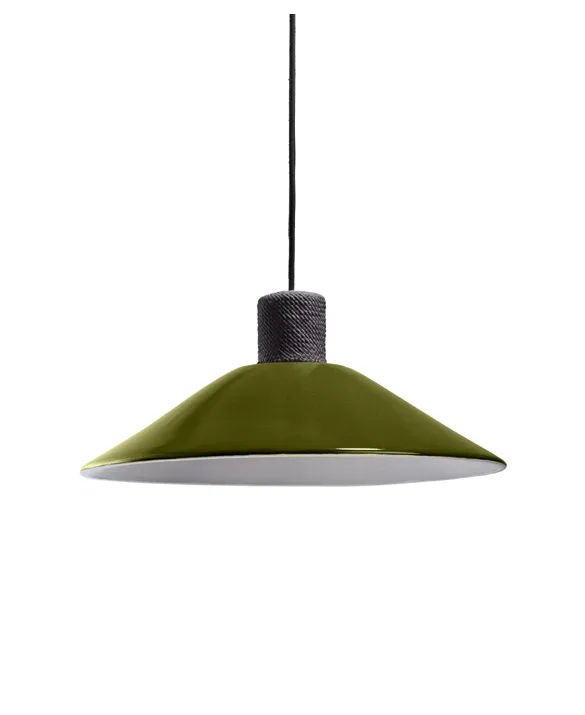Guapi
Collection: Guapi
Thought by: Ames
Category: Accessories
Thought by: Ames
|
Category: Accessories

Guapi vases designed by Mae Engelgeer, enrich any space with their eccentric, sculptural shape and textured, delicately shimmering surface from natural fibers made from the Chocolatillo palm.
Designed by
Mae Engelgeer


Mae Engelgeer developed the design of these vessels after learning about "cuatro tetas," the traditional baskets of the Eperaara Siapidaara people in southwest Colombia.
Their women make these baskets from the leaves of the Chocolatillo palm, applying different weaving techniques in one piece so that various motifs decorate a single piece.
Inspired by the concept of combining multiple weaving styles into one object, Mae developed the striking shape of the two Guapi vases. Mae chose this name for the collection as an ode to the Guapi region, located on the Pacific coast of Colombia, since this is where baskets have traditionally been made.
''I wanted to create unusual shapes with a playful look, so that they would come to life, like the large circles on the sides, which almost look like huge ears,'' she says about the collection.
To turn her design into reality, Mae worked closely with Colombian artisans in Guapi's ateliers because ancient techniques had to be rethought to create the vase's clean lines. With its natural texture and eye-catching design, the Guapi vase enlivens any space.
Their women make these baskets from the leaves of the Chocolatillo palm, applying different weaving techniques in one piece so that various motifs decorate a single piece.
Inspired by the concept of combining multiple weaving styles into one object, Mae developed the striking shape of the two Guapi vases. Mae chose this name for the collection as an ode to the Guapi region, located on the Pacific coast of Colombia, since this is where baskets have traditionally been made.
''I wanted to create unusual shapes with a playful look, so that they would come to life, like the large circles on the sides, which almost look like huge ears,'' she says about the collection.
To turn her design into reality, Mae worked closely with Colombian artisans in Guapi's ateliers because ancient techniques had to be rethought to create the vase's clean lines. With its natural texture and eye-catching design, the Guapi vase enlivens any space.
Product name
Guapi
Designer
Mae Engelgeer
Dimensions
Guapi 1:
Height: 60 cm
Width: 80 cm
Depth: 80 cm
Guapi 2:
Height: 80 cm
Width: 80 cm
Depth: 80 cm
Guapi 3:
Height: 90 cm
Width: 80 cm
Depth: 80 cm
Height: 60 cm
Width: 80 cm
Depth: 80 cm
Guapi 2:
Height: 80 cm
Width: 80 cm
Depth: 80 cm
Guapi 3:
Height: 90 cm
Width: 80 cm
Depth: 80 cm
Production process
Making beautiful objects from the fibers of the Tetera and Chocolatillo palms is an age-old skill that the women of the indigenous Eperaara Siapidaara have mastered.
Their communities live in Colombia's lush Guapi region, which stretches along Colombia's Pacific coast. An elaborate process turns palm leaves into fibers: the young palm tree - only two leaves can be grown - is extracted. two leaves - is pulled from the ground and the roots are separated. The artisans then peel the stem with a knife and let the strips dry in the shade. In the next step, they roll the bottles onto the stems to flatten them and then, extract the pulp.
Next, the stem is cut vertically, where they remove strings five to ten centimeters long.
Local flowers and roots are used to dye the strings, crushed with a stone, and mixed with water. The palm fibers are "cooked" for an hour in this mixture and, after being rinsed, are left to air dry. The water used for dyeing is reused for the next batch of fibers.
Weaving the design takes artisans up to eight days. The artisans
weave the body of the vase by working with a metal framework created especially for making Guapi vases, which takes up to four days. The two small ears are made with a different weaving technique and are attached by weaving them into the body of the vase.
Their communities live in Colombia's lush Guapi region, which stretches along Colombia's Pacific coast. An elaborate process turns palm leaves into fibers: the young palm tree - only two leaves can be grown - is extracted. two leaves - is pulled from the ground and the roots are separated. The artisans then peel the stem with a knife and let the strips dry in the shade. In the next step, they roll the bottles onto the stems to flatten them and then, extract the pulp.
Next, the stem is cut vertically, where they remove strings five to ten centimeters long.
Local flowers and roots are used to dye the strings, crushed with a stone, and mixed with water. The palm fibers are "cooked" for an hour in this mixture and, after being rinsed, are left to air dry. The water used for dyeing is reused for the next batch of fibers.
Weaving the design takes artisans up to eight days. The artisans
weave the body of the vase by working with a metal framework created especially for making Guapi vases, which takes up to four days. The two small ears are made with a different weaving technique and are attached by weaving them into the body of the vase.
Year
2023















